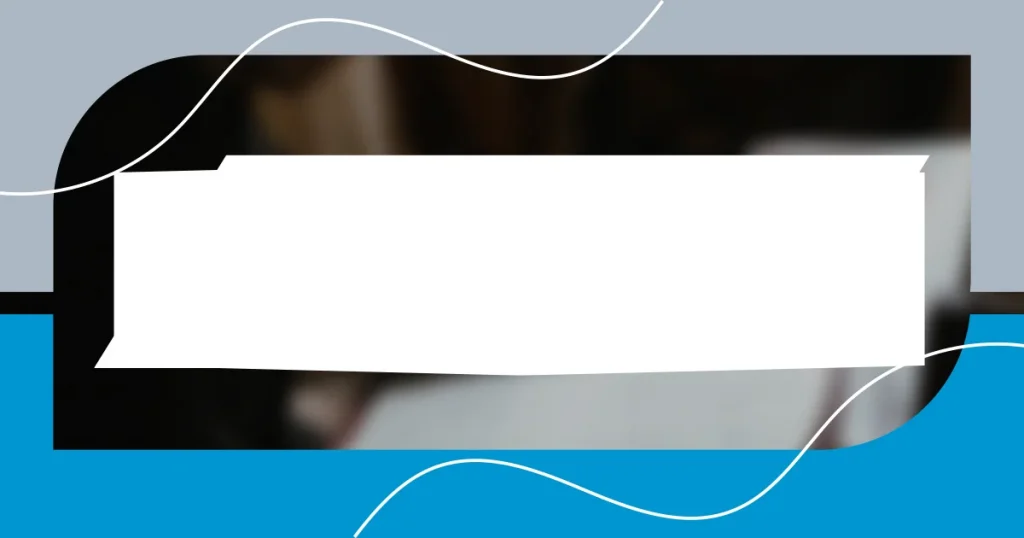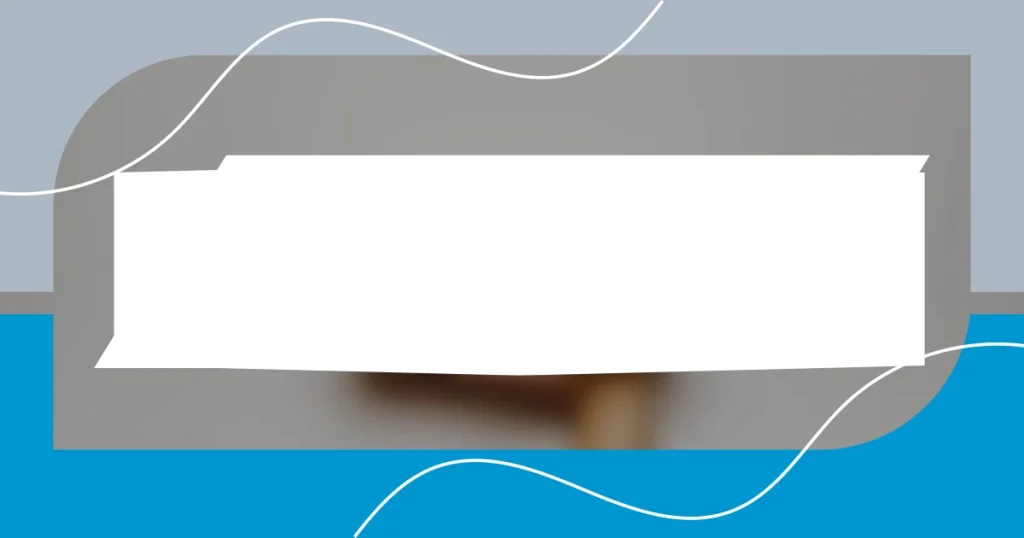Key takeaways:
- Authenticity and emotional connections during book signings can transform simple interactions into meaningful exchanges.
- Careful preparation, including materials, atmosphere, and engagement strategies, is crucial for a successful event.
- Following up after the signing with personalized gestures and feedback strengthens relationships with readers and enhances future events.

Introduction to book signings
Book signings are more than just events; they’re a unique opportunity for authors to connect with their readers on a personal level. I still remember my first signing—nervous yet excited, I found myself standing behind a table with a stack of my own books, feeling a surreal mix of disbelief and pride. Have you ever experienced that thrill of sharing your work, knowing it’s touched someone’s life?
As readers approach, you can feel the atmosphere shift; there’s an energy buzzing in the air, fueled by curiosity and admiration. I vividly recall a moment when a young reader told me how my story inspired her during a tough time. That heartfelt exchange made me realize how deeply meaningful these interactions can be. Have you ever thought about the power of a simple signature turned into a connection?
Attending a book signing can be an emotional rollercoaster for both the author and the reader. Each signature, each conversation, tells a story of impact and inspiration. It’s fascinating to consider how many stories and experiences converge at that small table. Isn’t it compelling how a fleeting moment can create lifelong memories?

Preparing for a book signing
When preparing for a book signing, the first step I take is to gather all my materials. This includes my books, pens, promotional items, and a prepared speech or talking points. I remember the first time I did this—my table was cluttered with everything imaginable, and I felt overwhelmed. Now, I keep it simple, ensuring everything is organized and looks inviting for readers.
Next, I focus on practicing my interactions. It might sound quirky, but I like to rehearse greetings and responses to common questions. One time, before a signing, I didn’t practice and stumbled over my words when someone asked about my inspiration. It highlighted for me the importance of being prepared, not just with my materials, but also mentally. Connecting with readers is smoother when I feel confident and ready.
Lastly, I always consider the atmosphere of the event. Is there background music? What’s the lighting like? Once, at a bookstore, the dim lighting made it hard to engage with readers, which sparked my interest in scouting locations ahead of time. It’s interesting how these small details can impact the overall experience for both the author and the attendees.
| Key Preparation Aspect | My Approach |
|---|---|
| Materials | Organized book displays & essential items |
| Practice Interaction | Rehearse greetings and answers to questions |
| Atmosphere | Consider lighting and background music |

Tips for engaging readers
I’ve learned that engaging with readers during book signings is all about authenticity. Being genuine helps to establish a connection. For instance, instead of just signing books mechanically, I greet readers with a smile and ask them about their thoughts on my writing. This simple act often leads to deeper conversations, and I treasure those moments.
Here are some strategies I suggest to create engaging interactions:
- Ask open-ended questions: Encourage readers to share their experiences with your work, which fosters a two-way conversation.
- Share your journey: Offering personal insights about how you crafted your story can intrigue readers and create a bond.
- Personalize each signing: Include a brief note or a personal touch, like mentioning a shared interest based on their responses.
- Use humor: A little lightheartedness can ease any tension, both for the author and the reader.
- Be present: Maintaining eye contact and showing genuine interest keeps the interaction meaningful and memorable.
These tips have enriched my signings, transforming them from simple transactions into rewarding exchanges filled with laughter and inspiration. Each interaction, no matter how brief, can leave a lasting impression, both on the reader and on me.

Setting up a successful event
Setting up a successful book signing event requires careful planning and attention to detail. I remember one instance where I overlooked the importance of confirming the venue. On the day of the signing, I arrived only to find that my reserved spot had been double-booked. This taught me the significance of always confirming arrangements ahead of time to avoid any last-minute surprises.
Another critical aspect is promoting the event effectively. I’ve learned that leveraging social media platforms can dramatically increase attendance. In one of my earlier signings, I created a buzz on Instagram by sharing behind-the-scenes preparation footage. It generated excitement, and I was thrilled to see a line of eager readers on the day of the event, all thanks to a little promotion that made a big difference.
Lastly, I’ve realized that being adaptable is key. During one signing, a surprise thunderstorm forced us to move indoors, and instead of panicking, I used the moment to engage attendees with an impromptu Q&A session. It’s these unforeseen moments that can turn into special memories, reminding me that flexibility can lead to the unexpected joys of connecting with my audience.

Handling book signing logistics
Handling the logistics of a book signing can be a bit daunting, but with careful preparation, it becomes manageable. I remember my first signing; I didn’t anticipate how crucial it was to have enough pens and bookmarks. You wouldn’t believe the panic I felt when I realized I was down to my last pen halfway through the event! Since then, I always make a checklist of supplies. Have you ever had that moment when everything seems to go sideways? Having extra supplies on hand can save you from potential embarrassment.
Another key element I’ve learned is the importance of setting up the signing area. I try to create an inviting space that reflects the tone of my book. For instance, during one signing, I arranged my table with themed decorations that echoed my book’s essence. It felt like stepping into a little world I had created. The atmosphere not only attracted more readers but also helped them feel more connected to the story. I can’t stress enough how the right setting can enhance the experience—wouldn’t you feel more excited to visit a booth that feels alive?
Lastly, consider your schedule—being mindful of timing can make all the difference. I’ve found that breaking the signing into blocks allows for more meaningful interactions. I used to pack my schedule too tightly, rushing from one reader to the next. This often left me feeling drained. Now, I build in short breaks. They not only give me a moment to recharge but also allow time for unexpected conversations with readers. Isn’t it refreshing to have a little time to breathe amidst the hustle? Balancing time spent with readers while keeping the event flowing is an art I continue to perfect.

Following up after the event
Following up after a book signing can truly deepen the connections you’ve made. I make it a point to send personalized thank-you notes to attendees who engaged with me. It’s amazing how such a simple gesture can leave a lasting impression. Have you ever received a heartfelt note from someone you admire? It creates a real sense of community around your work.
One thing I’ve learned is the power of social media in maintaining that connection. After an event, I often post photos and highlights on my platforms, tagging attendees where possible. This not only acknowledges their support but also encourages them to share their experiences. Just the other day, I had a reader reach out to tell me how much she enjoyed the event, and we ended up having a delightful conversation online. Isn’t it wonderful how technology can foster these relationships even after the event has wrapped up?
Lastly, I find it important to seek feedback on the event itself. I usually send out a quick survey to those who attended, asking for their thoughts on what worked well and what could be improved. This feedback not only helps me tailor future signings but also shows readers that their opinions matter. Remember that time when someone asked for your input, and you felt valued? That’s the feeling I aim to cultivate with my audience.

Lessons learned from my experiences
I’ve come to realize that flexibility is essential during a book signing. The very first time I did a signing, I noticed that not everything went as planned. An event I had envisioned as bustling turned out quite slow, and I almost felt disheartened. However, instead of sulking, I decided to engage with the few attendees who came by, sharing stories and signing books more intimately. It became an unexpectedly delightful experience, reminding me that sometimes, the quieter moments can lead to the most genuine connections. Have you ever had a plan go awry only to discover a hidden gem in the unforeseen?
Another crucial lesson revolves around the significance of storytelling beyond the pages of my book. During one memorable signing, I shared snippets of my writing journey with readers, and the room buzzed with enthusiasm. People were eager to talk about their own writing, their dreams, and even their struggles. That day taught me that my experiences and authenticity can resonate more deeply than my book alone. Isn’t it fascinating how a simple conversation can forge bonds that transcend the authored words?
Above all, I’ve learned to embrace vulnerability. I remember feeling nervous at an event where I was faced with a sea of unfamiliar faces. Instead of keeping my guard up, I chose to connect with the audience by sharing my personal struggles as a writer. The reactions were heartwarming; several people approached me afterward, sharing their own journeys. It reinforced a valuable lesson: allowing myself to be vulnerable not only humanizes me but also creates a safe space for others to share. Have you ever noticed how vulnerability can soften barriers and lead to richer conversations?
















